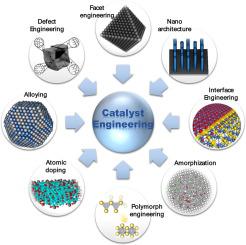当前位置:
X-MOL 学术
›
Engineering
›
论文详情
Our official English website, www.x-mol.net, welcomes your feedback! (Note: you will need to create a separate account there.)
Energy Conversion from Water to Water: Water Electrolysis and the Hydrogen Fuel Cell
Engineering ( IF 12.8 ) Pub Date : 2020-06-01 , DOI: 10.1016/j.eng.2019.07.028 Lishan Peng , Zidong Wei
Engineering ( IF 12.8 ) Pub Date : 2020-06-01 , DOI: 10.1016/j.eng.2019.07.028 Lishan Peng , Zidong Wei

|
Abstract In the context of the current serious problems related to energy demand and climate change, substantial progress has been made in developing a sustainable energy system. Electrochemical hydrogen–water conversion is an ideal energy system that can produce fuels via sustainable, fossil-free pathways. However, the energy conversion efficiency of two functioning technologies in this energy system—namely, water electrolysis and the fuel cell—still has great scope for improvement. This review analyzes the energy dissipation of water electrolysis and the fuel cell in the hydrogen–water energy system and discusses the key barriers in the hydrogen- and oxygen-involving reactions that occur on the catalyst surface. By means of the scaling relations between reactive intermediates and their apparent catalytic performance, this article summarizes the frameworks of the catalytic activity trends, providing insights into the design of highly active electrocatalysts for the involved reactions. A series of structural engineering methodologies (including nanoarchitecture, facet engineering, polymorph engineering, amorphization, defect engineering, element doping, interface engineering, and alloying) and their applications based on catalytic performance are then introduced, with an emphasis on the rational guidance from previous theoretical and experimental studies. The key scientific problems in the electrochemical hydrogen–water conversion system are outlined, and future directions are proposed for developing advanced catalysts for technologies with high energy-conversion efficiency.
中文翻译:

从水到水的能量转换:水电解和氢燃料电池
摘要 在当前能源需求和气候变化等严重问题的背景下,发展可持续能源系统取得了实质性进展。电化学氢水转化是一种理想的能源系统,可以通过可持续的无化石途径生产燃料。然而,该能源系统中的两种功能技术——水电解和燃料电池——的能量转换效率仍有很大的提升空间。这篇综述分析了氢-水能源系统中水电解和燃料电池的能量耗散,并讨论了发生在催化剂表面的氢和氧反应中的关键障碍。通过反应中间体与其表观催化性能之间的比例关系,本文总结了催化活性趋势的框架,为相关反应的高活性电催化剂的设计提供了见解。然后介绍了一系列基于催化性能的结构工程方法(包括纳米结构、小平面工程、多晶型工程、非晶化、缺陷工程、元素掺杂、界面工程和合金化)及其应用,强调了前人的合理指导。理论和实验研究。概述了电化学氢-水转化系统中的关键科学问题,并提出了为高能量转化效率技术开发先进催化剂的未来方向。为相关反应的高活性电催化剂的设计提供见解。然后介绍了一系列基于催化性能的结构工程方法(包括纳米结构、小平面工程、多晶型工程、非晶化、缺陷工程、元素掺杂、界面工程和合金化)及其应用,强调了前人的合理指导。理论和实验研究。概述了电化学氢-水转化系统中的关键科学问题,并提出了为高能量转化效率技术开发先进催化剂的未来方向。为相关反应的高活性电催化剂的设计提供见解。然后介绍了一系列基于催化性能的结构工程方法(包括纳米结构、小平面工程、多晶型工程、非晶化、缺陷工程、元素掺杂、界面工程和合金化)及其应用,强调了前人的合理指导。理论和实验研究。概述了电化学氢-水转化系统中的关键科学问题,并提出了为高能量转化效率技术开发先进催化剂的未来方向。然后介绍了多晶型工程、非晶化、缺陷工程、元素掺杂、界面工程和合金化)及其基于催化性能的应用,并强调了先前理论和实验研究的合理指导。概述了电化学氢-水转化系统中的关键科学问题,并提出了为高能量转化效率技术开发先进催化剂的未来方向。然后介绍了多晶型工程、非晶化、缺陷工程、元素掺杂、界面工程和合金化)及其基于催化性能的应用,并强调了先前理论和实验研究的合理指导。概述了电化学氢-水转化系统中的关键科学问题,并提出了为高能量转化效率技术开发先进催化剂的未来方向。
更新日期:2020-06-01
中文翻译:

从水到水的能量转换:水电解和氢燃料电池
摘要 在当前能源需求和气候变化等严重问题的背景下,发展可持续能源系统取得了实质性进展。电化学氢水转化是一种理想的能源系统,可以通过可持续的无化石途径生产燃料。然而,该能源系统中的两种功能技术——水电解和燃料电池——的能量转换效率仍有很大的提升空间。这篇综述分析了氢-水能源系统中水电解和燃料电池的能量耗散,并讨论了发生在催化剂表面的氢和氧反应中的关键障碍。通过反应中间体与其表观催化性能之间的比例关系,本文总结了催化活性趋势的框架,为相关反应的高活性电催化剂的设计提供了见解。然后介绍了一系列基于催化性能的结构工程方法(包括纳米结构、小平面工程、多晶型工程、非晶化、缺陷工程、元素掺杂、界面工程和合金化)及其应用,强调了前人的合理指导。理论和实验研究。概述了电化学氢-水转化系统中的关键科学问题,并提出了为高能量转化效率技术开发先进催化剂的未来方向。为相关反应的高活性电催化剂的设计提供见解。然后介绍了一系列基于催化性能的结构工程方法(包括纳米结构、小平面工程、多晶型工程、非晶化、缺陷工程、元素掺杂、界面工程和合金化)及其应用,强调了前人的合理指导。理论和实验研究。概述了电化学氢-水转化系统中的关键科学问题,并提出了为高能量转化效率技术开发先进催化剂的未来方向。为相关反应的高活性电催化剂的设计提供见解。然后介绍了一系列基于催化性能的结构工程方法(包括纳米结构、小平面工程、多晶型工程、非晶化、缺陷工程、元素掺杂、界面工程和合金化)及其应用,强调了前人的合理指导。理论和实验研究。概述了电化学氢-水转化系统中的关键科学问题,并提出了为高能量转化效率技术开发先进催化剂的未来方向。然后介绍了多晶型工程、非晶化、缺陷工程、元素掺杂、界面工程和合金化)及其基于催化性能的应用,并强调了先前理论和实验研究的合理指导。概述了电化学氢-水转化系统中的关键科学问题,并提出了为高能量转化效率技术开发先进催化剂的未来方向。然后介绍了多晶型工程、非晶化、缺陷工程、元素掺杂、界面工程和合金化)及其基于催化性能的应用,并强调了先前理论和实验研究的合理指导。概述了电化学氢-水转化系统中的关键科学问题,并提出了为高能量转化效率技术开发先进催化剂的未来方向。

























 京公网安备 11010802027423号
京公网安备 11010802027423号